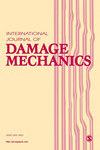纤维加固和混合加固混凝土梁最小配筋设计的断裂力学方法
IF 3.9
2区 工程技术
Q2 MATERIALS SCIENCE, MULTIDISCIPLINARY
引用次数: 0
摘要
在断裂力学框架内,通过更新桥式裂缝模型(UBCM)解决了纤维加固和混合加固混凝土抗弯构件的最小加固条件问题。该模型通过将复合材料假定为多相材料,对水泥基质和钢筋的增韧作用进行独立评估,从而描述了加固构件临界截面上的裂纹扩展过程。讨论的要点是,当忽略基体非线性对响应的影响时,最小加固条件由两个无量纲数临界值之间的线性关系定义:(i) 钢筋脆性数 NP,与钢筋面积百分比 ρ 成比例;(ii) 纤维脆性数 NP,f,与纤维体积分数 Vf 成比例。该模型适用于文献中的多个实验活动,以评估其在基于断裂力学的统一框架下,是否适用于钢筋构件的最小配筋设计。本文章由计算机程序翻译,如有差异,请以英文原文为准。
Fracture mechanics approach to minimum reinforcement design of fibre-reinforced and hybrid-reinforced concrete beams
The problem of the minimum reinforcement condition in fibre-reinforced and hybrid-reinforced concrete flexural elements is addressed in the framework of fracture mechanics by means of the Updated Bridged Crack Model (UBCM). The model describes the crack propagation process occurring in the critical cross-section of the reinforced member, by assuming the composite as a multiphase material, whereby the toughening contribution of the cementitious matrix and of the reinforcements are independently evaluated. The key-point of the discussion is that, when the influence of the matrix nonlinearities on the response is neglected, the minimum reinforcement condition is defined by a linear relationship between the critical values of two dimensionless numbers: (i) the bar- reinforcement brittleness number, NP , proportional to the steel-bar area percentage, ρ; (ii) the fibre- reinforcement brittleness number, NP,f , proportional to the fibre volume fraction, Vf . The model is applied to several experimental campaigns of the literature, in order to assess its suitability in the minimum reinforcement design of reinforced members in a unified fracture mechanics-based framework.
求助全文
通过发布文献求助,成功后即可免费获取论文全文。
去求助
来源期刊

International Journal of Damage Mechanics
工程技术-材料科学:综合
CiteScore
8.70
自引率
26.20%
发文量
48
审稿时长
5.4 months
期刊介绍:
Featuring original, peer-reviewed papers by leading specialists from around the world, the International Journal of Damage Mechanics covers new developments in the science and engineering of fracture and damage mechanics.
Devoted to the prompt publication of original papers reporting the results of experimental or theoretical work on any aspect of research in the mechanics of fracture and damage assessment, the journal provides an effective mechanism to disseminate information not only within the research community but also between the reseach laboratory and industrial design department.
The journal also promotes and contributes to development of the concept of damage mechanics. This journal is a member of the Committee on Publication Ethics (COPE).
 求助内容:
求助内容: 应助结果提醒方式:
应助结果提醒方式:


